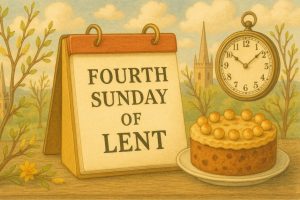Mothering Sunday in the UK has its roots in Christian tradition, not in social activism or commercial initiatives like in the US.
The celebration dates back to the 16th century and was closely tied to the practice of visiting one’s mother church, the church where a person was baptised or their local parish church on the fourth Sunday in Lent.
This pilgrimage was more than spiritual; it was a rare occasion when domestic servants and apprentices were allowed to go home.
Often working far from their families, these individuals would take the opportunity to reunite with their mothers, making the occasion one of family togetherness and maternal appreciation.
In those early days, families marked the event with gifts such as Simnel cake, a rich fruit cake topped with marzipan, and other Lenten treats like mothering buns or fig pie.
Although the day was religious in origin, over the centuries it evolved into a more secular celebration, retaining its maternal focus.
When Is Mother’s Day Celebrated in the UK and Why?

In the UK, Mother’s Day or more accurately, Mothering Sunday is celebrated on the fourth Sunday in Lent, a date that shifts each year based on the ecclesiastical calendar.
This connection to Lent makes the UK’s observance moveable, unlike the fixed date used in many other countries.
Example Dates for Mothering Sunday in Upcoming Years:
| Year | Date (UK – Mothering Sunday) |
| 2024 | 10th March |
| 2025 | 30th March |
| 2026 | 15th March |
This shifting date often causes confusion, especially when international retailers or online platforms promote the American date, which is fixed on the second Sunday in May.
How Does UK Mother’s Day Differ from the US Version?
While both the UK and the US use the term “Mother’s Day” and honour mothers in similar ways, the differences in history, date, and traditions are substantial.
Origins in Contrast
- UK: Originates from a Christian custom Mothering Sunday tied to visiting one’s local church during Lent.
- US: Introduced in 1908 by Anna Jarvis, inspired by her mother’s humanitarian work. Officially recognised in 1914 by President Woodrow Wilson as a national holiday.
The US version of Mother’s Day was never religious in nature; it was rooted in social advocacy and later developed into a day of nationwide gratitude towards mothers.
How Did Mothering Sunday Evolve into Mother’s Day in the UK?

The blending of UK and US traditions began in earnest during and after World War II, when American troops stationed in Britain brought their customs with them.
Over time, UK retailers adopted the American terminology, using “Mother’s Day” in marketing campaigns. However, the UK retained its unique timing and religious undertone, despite the gradual secularisation of the holiday.
By the late 20th century, “Mothering Sunday” had become less commonly used outside church circles, replaced in everyday conversation by “Mother’s Day” but the celebration’s calendar placement in March persisted.
What Are the Traditional UK Customs for Mothering Sunday?
Historically, Mothering Sunday included a variety of unique practices that differentiated it from the more commercialised American version.
- Simnel Cake: Originally a treat reserved for Laetare Sunday (another name for the fourth Sunday of Lent), this rich fruitcake became a Mothering Sunday staple.
- Church Visits: Entire families would attend services at their mother church.
- Floral Tributes: Children would gather wildflowers en route to church and present them to their mothers.
- Relaxation of Lenten Austerity: Although Lent called for fasting and modesty, Mothering Sunday allowed for a temporary break, encouraging small feasts and celebrations.
Today, many of these customs have been replaced or modified, yet the core idea of expressing love and appreciation for mothers endures.
Why Do People Get Confused About the Date of Mother’s Day in the UK?

This confusion is largely due to globalisation and digital media. With much of the internet and advertising driven by US-based platforms, UK audiences are frequently exposed to messaging tied to the American Mother’s Day in May.
Retailers, especially multinational brands, often release campaigns that don’t differentiate between national calendars.
For UK consumers, this results in duplicate reminders, and even misaligned celebrations if attention isn’t paid to local tradition.
Some families in the UK have even reported celebrating twice once in March and again in May due to influence from family members living abroad or exposure to international content.
When Do Other Countries Celebrate Mother’s Day?
Mother’s Day is observed in different ways and on different dates around the world, based on religious, political, or cultural factors.
| Country | Local Name | Celebration Date | Origin Type |
| UK | Mothering Sunday | Fourth Sunday of Lent | Religious (Christian) |
| USA | Mother’s Day | Second Sunday in May | Secular/Social Activism |
| Australia | Mother’s Day | Second Sunday in May | US Influence |
| France | Fête des Mères | Last Sunday in May | Secular |
| Mexico | Día de las Madres | 10th May | Cultural |
| Ethiopia | Antrosht | End of Rainy Season | Religious/Cultural |
The cultural emphasis may vary, but the message is usually consistent: honouring and appreciating mothers for their role in family and society.
Does the Meaning of Mother’s Day Change Even If the Date Does?
Although celebrated on different days, the essence of Mother’s Day is universally resonant. In both the UK and the US, the day has become synonymous with:
- Showing appreciation
- Reinforcing family values
- Celebrating maternal love
It’s also a time when emotional connections take precedence over commercialism. A handwritten note, shared meal, or spring bouquet can carry as much meaning as expensive gifts.
What Can We Learn from the UK’s Unique Mother’s Day Tradition?

The UK’s celebration of Mother’s Day is a compelling example of how tradition and modernity can coexist. Its roots in Christian heritage give it a depth of meaning often lost in more commercialised celebrations.
At the same time, the incorporation of modern customs from cards to flowers ensures the tradition remains relevant.
It also highlights the power of cultural identity. Despite international influences, the UK has preserved the timing and character of its original Mothering Sunday.
Beyond personal expressions of love, the day fosters stronger intergenerational bonds and contributes significantly to the UK economy.
Retail sectors see increased activity in areas like floristry, dining, and gift sales, underscoring how deeply this tradition is woven into British life.
FAQs About Why Mother’s Day Is Different in the UK
What is the history behind Mothering Sunday?
It began as a Christian observance tied to visiting the mother church on the fourth Sunday of Lent, later becoming a day to honour individual mothers.
Why does the UK celebrate Mother’s Day in March?
The UK follows the ecclesiastical calendar, celebrating on the fourth Sunday of Lent rather than a fixed date.
Is Mothering Sunday still religious today?
While it retains spiritual roots, today it is more commonly celebrated in a secular, family-focused way.
How is UK Mother’s Day different from US Mother’s Day?
UK Mother’s Day is older, rooted in religion, and celebrated in March, whereas the US version was founded in 1908 and takes place in May.
When did the UK start using the term “Mother’s Day”?
Post-WWII, American culture influenced the UK’s terminology, although the date and meaning stayed distinct.
Why do online ads show the wrong date for Mother’s Day?
Many online platforms follow the American calendar, causing confusion for UK users.
Do all countries celebrate Mother’s Day the same way?
No, different countries have different customs and dates based on religious, cultural, or social influences.






